For the 2025 school year, there is 1 public preschool serving 283 students in Hackettstown Public School District.
Public Preschools in Hackettstown Public School District have a diversity score of 0.58, which is less than the New Jersey public preschool average of 0.71.
Minority enrollment is 61% of the student body (majority Hispanic), which is less than the New Jersey public preschool average of 64% (majority Hispanic).
Overview
This School District
This State (NJ)
# Schools
4 Schools
924 Schools
# Students
2,009 Students
368,931 Students
# Teachers
183 Teachers
33,283 Teachers
Student : Teacher Ratio
11:1
11:1
District Rank
Hackettstown Public School District, which is ranked within the top 50% of all 646 school districts in New Jersey (based off of combined math and reading proficiency testing data) for the 2021-2022 school year.
The school district's graduation rate of 80% has decreased from 94% over five school years.
Overall District Rank
#297 out of 650 school districts
(Top 50%)
(Top 50%)
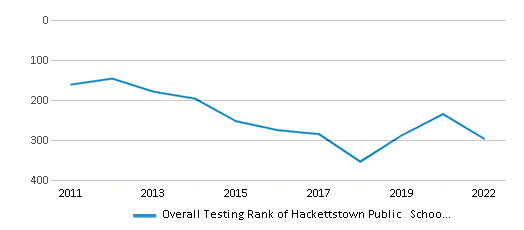
Math Test Scores (% Proficient)
41%
36%
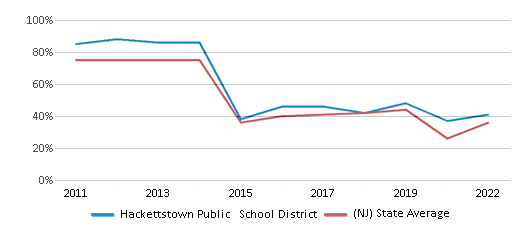
Reading/Language Arts Test Scores (% Proficient)
52%
49%

Science Test Scores (% Proficient)
25%
23%
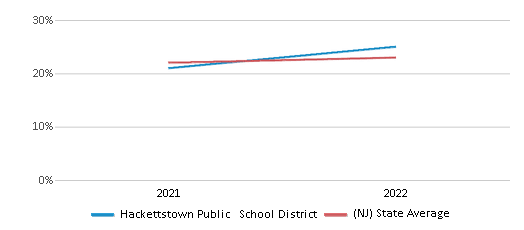
Graduation Rate
80%
85%
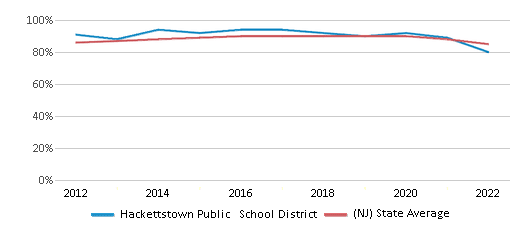
Students by Ethnicity:
Diversity Score
0.59
0.71
# American Indian Students
4 Students
901 Students
% American Indian Students
n/a
n/a
# Asian Students
70 Students
30,033 Students
% Asian Students
4%
8%
# Hispanic Students
744 Students
132,928 Students
% Hispanic Students
37%
36%
# Black Students
78 Students
58,834 Students
% Black Students
4%
16%
# White Students
1,047 Students
132,766 Students
% White Students
52%
36%
# Hawaiian Students
2 Students
790 Students
% Hawaiian Students
n/a
n/a
# Two or more races Students
57 Students
12,631 Students
% of Two or more races Students
3%
4%
Students by Grade:
# Students in PK Grade:
56
59,693
# Students in K Grade:
120
56,070
# Students in 1st Grade:
107
51,032
# Students in 2nd Grade:
108
50,036
# Students in 3rd Grade:
106
42,983
# Students in 4th Grade:
140
37,934
# Students in 5th Grade:
124
29,352
# Students in 6th Grade:
117
15,586
# Students in 7th Grade:
117
11,676
# Students in 8th Grade:
125
11,589
# Students in 9th Grade:
223
663
# Students in 10th Grade:
239
626
# Students in 11th Grade:
201
579
# Students in 12th Grade:
226
1,080
# Ungraded Students:
-
32
District Revenue and Spending
The revenue/student of $20,338 in this school district is less than the state median of $26,931. The school district revenue/student has stayed relatively flat over four school years.
The school district's spending/student of $20,536 is less than the state median of $25,828. The school district spending/student has stayed relatively flat over four school years.
Total Revenue
$41 MM
$36,642 MM
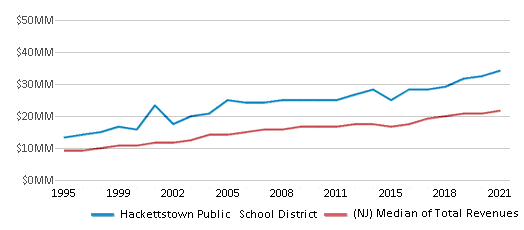
Spending
$41 MM
$35,142 MM

Revenue / Student
$20,338
$26,931

Spending / Student
$20,536
$25,828
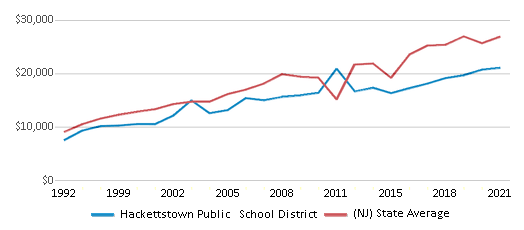
Best Hackettstown Public School District Public Preschools (2025)
School
(Math and Reading Proficiency)
(Math and Reading Proficiency)
Location
Grades
Students
Rank: #11.
Hatchery Hill Elementary School
(Math: 55-59% | Reading: 55-59% )
Rank:
Rank:
6/
Top 50%10
398 5th Avenue
Hackettstown, NJ 07840
(908) 852-8550
Hackettstown, NJ 07840
(908) 852-8550
Grades: PK-1
| 283 students
Recent Articles

Year-Round Or Traditional Schedule?
Which is more appropriate for your child? A year-round attendance schedule or traditional schedule? We look at the pros and cons.

Why You Should Encourage Your Child to Join a Sports Team
Participating in team sports has a great many benefits for children, there is no doubt. In this article you will learn what those benefits are.

White Students are Now the Minority in U.S. Public Schools
Increasing birth rates among immigrant families from Asia and Central and South America, combined with lower birth rates among white families, means that for the first time in history, public school students in the United States are majority-minority. This shift in demographics poses difficulties for schools as they work to accommodate children of varying language abilities and socio-economic backgrounds.





